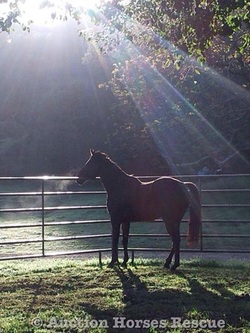
Singlestar was a sweet young Thoroughbred, rescued at auction in January by AHR, with the help of After the Finish Line. Just a few months since his last race at Los Alamitos, he bore the damages of racing -- multiple old fractures in his knee, that had been injected and re-injected, and continually raced on -- as well as severe high ringbone in both hinds.
Like so many horses, often what should defeat them, doesn't. Animals have a remarkable way of finding a comfort level they can operate on. At the time of rescue, it looked hopeful Singlestar could be one of those surprise successes. That despite the damage shown by xray, Singlestar could live a happy life as a companion, possibly even a light riding horse.
But over the past few weeks, it became clear life was only becoming more and more difficult for Singlestar. Rising in his stall, lifting his feet to be picked, were proving close to impossible without high dose bute.
So we gave Singlestar a great way to go out -- a green pasture we'd been nursing the past few months, and keeping all the horses off of, was now his, and his best friend, our Quarter Horse mare Catherine. Some ample round-the-clock bute, and all the treats he wanted. He got to hobble around, happy, trying to buck and play like he used to, before he was "broken."
But horses can't live on high-dose bute for more than a few days, before stomach ulceration sets in. And supplements and natural healing therapies are not miracle cures for advanced cases.
In the end, yesterday, Dr. Friedlander came to our ranch, and while one minute Singlestar was being a happy horse in a lush green field with his best friend, the next moment he went to sleep.
No excruciating pain, or terror from being shipped to slaughter. A 6-year-old baby who should've lived a long life, but who's body wasn't going to be able to let him.
Sometimes the most courageous thing is to let go.
Like so many horses, often what should defeat them, doesn't. Animals have a remarkable way of finding a comfort level they can operate on. At the time of rescue, it looked hopeful Singlestar could be one of those surprise successes. That despite the damage shown by xray, Singlestar could live a happy life as a companion, possibly even a light riding horse.
But over the past few weeks, it became clear life was only becoming more and more difficult for Singlestar. Rising in his stall, lifting his feet to be picked, were proving close to impossible without high dose bute.
So we gave Singlestar a great way to go out -- a green pasture we'd been nursing the past few months, and keeping all the horses off of, was now his, and his best friend, our Quarter Horse mare Catherine. Some ample round-the-clock bute, and all the treats he wanted. He got to hobble around, happy, trying to buck and play like he used to, before he was "broken."
But horses can't live on high-dose bute for more than a few days, before stomach ulceration sets in. And supplements and natural healing therapies are not miracle cures for advanced cases.
In the end, yesterday, Dr. Friedlander came to our ranch, and while one minute Singlestar was being a happy horse in a lush green field with his best friend, the next moment he went to sleep.
No excruciating pain, or terror from being shipped to slaughter. A 6-year-old baby who should've lived a long life, but who's body wasn't going to be able to let him.
Sometimes the most courageous thing is to let go.

 RSS Feed
RSS Feed